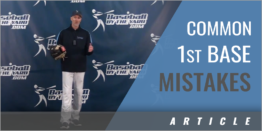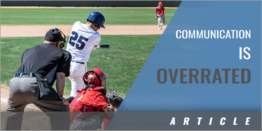|
By: Bob McCreary - Baseball By the Yard Aggressive base running is a valuable weapon for any offense. Putting runners in motion in all its forms puts a lot of pressure on a defense because they are forced to deal with multiple things at the same time – throwing, covering bases, chasing and fielding grounders, pop-ups, etc. The more things you make a defense think about and do, the more likely they will screw something up. The "hit and run" and the "run and hit" are good examples of offensive plays that accomplish this. Below are some thoughts and variations of both. The "Hit and Run." Coaches have different philosophies on how they want their players to handle a hit and run. Sometimes the philosophy is a strict rule for every player and sometimes it varies depending on who is hitting and who is running. Most people utilize a hit and run to stay out of a double play. They might put it on because the hitter hits a lot of ground balls. They may put it on because one or both runners are slow. It may be a case where the batter is terrible at bunting and the team has to get the runner in scoring position in a tight game. It may also be a situation where the pitcher is so fast to home (slide step) that even fast runners cannot straight steal. In all these situations, the priority is for the batter to protect the runner by swinging at virtually everything because the chances of the runner stealing on his own are very slim. The only exception might be to lay off a pitch that is thrown in the dirt. In this version, the hitter also must try to hit the ball on the ground. There are two reasons for this. One, to avoid a line-drive or pop-up being caught which then doubles off the runner, and Two, to take advantage of the open spot vacated by the fielder who is covering on the steal. Ideally, hitters should also try to keep the ball from being hit to the middle of the field. This is because a fielder will be in that area when they go to cover second base. Some coaches require their hitters to hit "behind the runner" on a hit and run meaning they want them to hit the ball to the right side so that the base runner has a better chance of being able to go from 1st to 3rd on the play. Other coaches make it a bit easier on the hitter and just tell them to pull a pitch on the inner half and hit an outer half pitch the other way. They do this because hitting the other way on any pitch (especially one on the inner half) is a very difficult skill for most young hitters. Another option for a hit and run is to try to score a run with one swing of the bat. This may be a better option when a good hitter is at the plate, a not so fast runner is on first, and the next few hitters are not that strong. This option has the hitter at the plate be more aggressive and try to drive the ball into the gap so the moving runner has a good chance to score from first base. To some coaches, telling a good hitter to just hit a ground ball to protect a runner is seen as a waste of a good hitter's at-bat. The hitter is still forced to swing but his responsibility is more tailored to his ability. The risk with this version is that the batter is not forced to hit a ground ball and may hit a line-drive or pop-up at someone which doubles off the runner. A coach must also be a bit more selective with this play because, ideally, he'll want to pick a situation where the hitter is more likely to get a fast ball strike. The "Run and Hit." This version of the hit and run usually involves a base runner who has some speed and therefore may have the ability to just steal a base without the hitter protecting him. It's sort of a cross between the last version of the hit and run I discussed and a straight steal. Many times a coach will tell a hitter to take the next pitch if the coach is fairly certain the runner will be safe on the steal to second. This enables the batter to hit with a runner in scoring position. The "run and hit" version has the runner at first try to steal second base as normal. The batter, however, does not have to swing. If it is a strike, the batter should be hacking to try and score the runner all the way from first or at least get him to third. If the pitch is out of the strike zone, the hitter is allowed to take it because it is likely the runner will steal successfully anyway. Some coaches have different signs for each version and some, as mentioned above, just go with one version for everyone. Other coaches have one sign but tell certain hitters to address it differently if they get the sign. Whatever a coach decides is based on their philosophy and their personnel. Regardless of why or how they do it, moving runners on the pitch can be a big part of an offensive strategy. About the Article... I am proud to come from a baseball family. My grandfather's (Mother's side) name was Hal Kelleher. He pitched for the Philadelphia Phillies in the 1930's. My father was a long time baseball coach at the youth, high school, and college levels. He even had a chance to coach in the College World Series while an assistant at Temple University in 1972. While in the military service, my father was stationed at Fort McPherson outside of Atlanta, Georgia which had a general that was a baseball fanatic. He did everything he could to bring major league players who were drafted into the Army to Fort McPherson. As a result, Fort McPherson was stacked and won the All-Army Championship as a result. My father played second base on that team. Being around those major leaguers was quite a learning experience for my Dad. He learned about the mental toughness of major leaguers and all the finer points that made them tremendous players. Because of all this, from the time I picked up a baseball, I was learning the finer points of the game. Many of the things I was learning at a young age are not generally taught to players until they get into the higher levels. I was very fortunate to have those good baseball people close to me. When I finished my playing career, I decided I wanted to pass on these finer points to as many players, coaches, and parents as I could. My coaching, this website, and especially my blog are all an attempt to do that. I hope you enjoy what I have to offer. If you are a player or coach, I hope that something you learn from me gives you a better chance at playing and/or coaching at the levels I have been fortunate to experience. Best of luck to all of you on your baseball journey! Bob McCreary |






